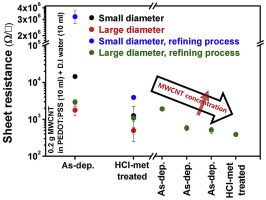Organic Electronics ( IF 3.2 ) Pub Date : 2017-10-07 , DOI: 10.1016/j.orgel.2017.10.007 Dong-Jin Yun , Yong Jin Jeong , Hyemin Ra , Jung-Min Kim , Tae Kyu An , Shi-Woo Rhee , Jaeyoung Jang

|
Multi-walled carbon nanotubes (MWCNTs) and polymer composites have attracted significant attention as metal-free electrode materials for various electronic devices. Many studies have presented strategies to enhance the electrical conductivity of MWCNT/polymer composites. However, systematic studies on the effects of MWCNT features on the composite properties are still missing. Such studies can further the development of MWCNT/polymer-based conducting materials. Herein, we characterize composite films of MWCNTs and poly(3,4-ethylenedioxythiophene) polymerized with poly(4-styrenesulfonate) (PEDOT:PSS), with variations in the MWCNT diameter and purity. MWCNT features greatly affect the physical/chemical/electrical properties of the MWCNT/PEDOT:PSS composite films. In addition, the diameter and purity of MWCNTs also influenced the transition behavior of the composite films during the hydrochloric acid-methanol treatment, which was performed for increasing electrical conductivity. As a result, we could optimize the performance of organic transistors and dye-sensitized solar cells (DSSCs) using MWCNT/PEDOT:PSS composite films as source/drain electrodes and catalytic counter electrodes, respectively. Furthermore, using the optimized device parameters, we successfully fabricated high performance fluorine doped tin oxide-free DSSCs and high-gain organic complementary inverters using MWCNT/PEDOT:PSS composite electrodes.
中文翻译:

用于有机晶体管和染料敏化太阳能电池的MWCNT-PEDOT:PSS复合电极的系统优化:MWCNT直径和纯度的影响
作为用于各种电子设备的无金属电极材料,多壁碳纳米管(MWCNT)和聚合物复合材料引起了广泛的关注。许多研究提出了提高MWCNT /聚合物复合材料电导率的策略。然而,关于碳纳米管特征对复合材料性能影响的系统研究仍然缺失。这样的研究可以进一步发展基于MWCNT /聚合物的导电材料。在这里,我们表征了MWCNTs和与聚(4-苯乙烯磺酸盐)(PEDOT:PSS)聚合的聚(3,4-乙撑二氧噻吩)的复合膜,其MWCNT直径和纯度有所变化。MWCNT的特征极大地影响了MWCNT / PEDOT:PSS复合膜的物理/化学/电学性质。此外,MWCNTs的直径和纯度也影响了复合膜在盐酸-甲醇处理过程中的过渡行为,这是为了提高电导率而进行的。结果,我们可以分别使用MWCNT / PEDOT:PSS复合膜作为源/漏电极和催化对电极来优化有机晶体管和染料敏化太阳能电池(DSSC)的性能。此外,使用优化的器件参数,我们使用MWCNT / PEDOT:PSS复合电极成功制造了高性能,无氟掺杂,无氧化锡的DSSC和高增益有机互补逆变器。我们可以分别使用MWCNT / PEDOT:PSS复合膜作为源/漏电极和催化对电极来优化有机晶体管和染料敏化太阳能电池(DSSC)的性能。此外,使用优化的器件参数,我们使用MWCNT / PEDOT:PSS复合电极成功制造了高性能,无氟掺杂,无氧化锡的DSSC和高增益有机互补逆变器。我们可以分别使用MWCNT / PEDOT:PSS复合膜作为源/漏电极和催化对电极来优化有机晶体管和染料敏化太阳能电池(DSSC)的性能。此外,使用优化的器件参数,我们使用MWCNT / PEDOT:PSS复合电极成功制造了高性能,无氟掺杂,无氧化锡的DSSC和高增益有机互补逆变器。



























 京公网安备 11010802027423号
京公网安备 11010802027423号